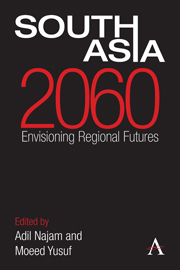Book contents
- Frontmatter
- Contents
- Acknowledgments
- List of Abbreviations
- Introduction: Imagining South Asian Futures
- Section I South Asia as a Region
- Section II State Relations
- Section III Development
- Chapter 16 South Asian Economy in 2060
- Chapter 17 Economic Futures: Challenges Ahead
- Chapter 18 South Asia in the Asian Economy: Struggling to Overcome History
- Chapter 19 Globalization and South Asia
- Chapter 20 Trade Relations: Some Predictions and Lessons
- Chapter 21 Urban Policy for Environmental Quality and Well-Being
- Chapter 22 Urban Futures, Urban Challenges
- Chapter 23 Water Security: Risks and Responses
- Chapter 24 Agriculture and Food Security
- Chapter 25 Meeting Electric Power Demand in South Asia
- Chapter 26 E-South Asia: A Social Science Fiction
- Section IV Human Well-Being
- About the Authors
- Bibliography
- Index
Chapter 17 - Economic Futures: Challenges Ahead
from Section III - Development
Published online by Cambridge University Press: 05 September 2013
- Frontmatter
- Contents
- Acknowledgments
- List of Abbreviations
- Introduction: Imagining South Asian Futures
- Section I South Asia as a Region
- Section II State Relations
- Section III Development
- Chapter 16 South Asian Economy in 2060
- Chapter 17 Economic Futures: Challenges Ahead
- Chapter 18 South Asia in the Asian Economy: Struggling to Overcome History
- Chapter 19 Globalization and South Asia
- Chapter 20 Trade Relations: Some Predictions and Lessons
- Chapter 21 Urban Policy for Environmental Quality and Well-Being
- Chapter 22 Urban Futures, Urban Challenges
- Chapter 23 Water Security: Risks and Responses
- Chapter 24 Agriculture and Food Security
- Chapter 25 Meeting Electric Power Demand in South Asia
- Chapter 26 E-South Asia: A Social Science Fiction
- Section IV Human Well-Being
- About the Authors
- Bibliography
- Index
Summary
With a population of more than 1.5 billion and with a population growth rate of nearly 2 percent per year, South Asia will soon become the most densely populated region in the world. The economy of South Asia as a region had been growing at a rate of 9 percent per annum, according to the World Bank, but has slowed down to around 6 percent in recent years due to the global recession. The economic performance of all the South Asian Association for Regional Cooperation (SAARC) countries is not, however, the same but they all, with the exception of Afghanistan and Nepal, have accomplished more than many other countries in the world (World Bank 2009). For example, in 2009, the rate of growth for export was registered around 21 percent and that of imports about 36 percent, indicating that the region has been strongly integrating with the world. Simultaneously however, the integration of South Asian economies among themselves is minimal; internally South Asia is the least integrated region of the world. Additionally, the growth rate of energy consumption is currently around 5 percent, while growth rate of energy demand is about 6 percent meaning that there is a persistent shortage of energy in the region.
- Type
- Chapter
- Information
- South Asia 2060Envisioning Regional Futures, pp. 132 - 140Publisher: Anthem PressPrint publication year: 2013



